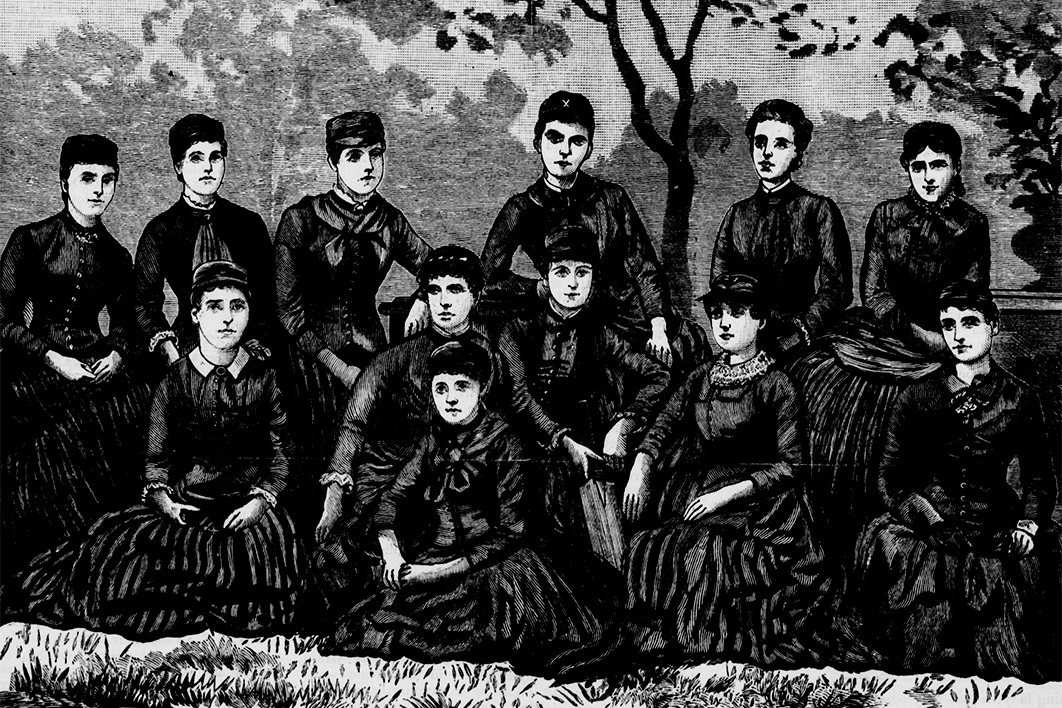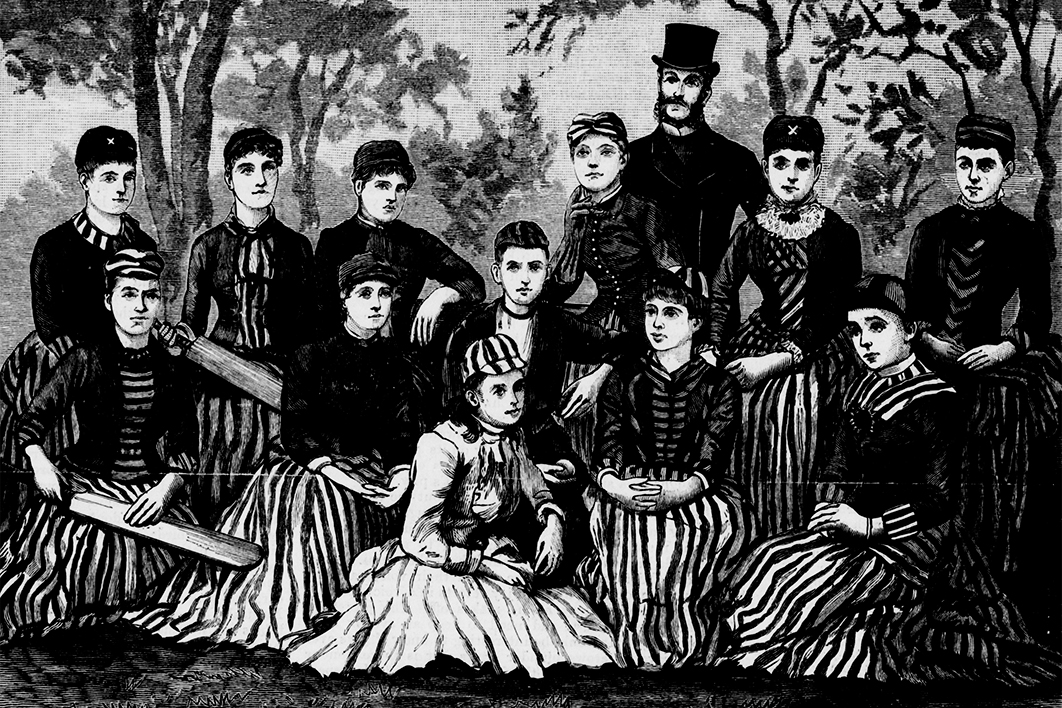Part of our collection of articles on Australian history’s missing women, in collaboration with the Australian Dictionary of Biograph
Every bowler dreams of a five-wicket haul. In 1886, Nellie Gregory took eight wickets for thirty-seven runs in the first innings of a match, then followed that up with six for a mere twelve runs in the second. Playing for the opposing team, her sister Louisa achieved 6/14 and 3/25. In the same game, Nellie top-scored during both her side’s innings.
Nellie and Louisa Gregory were the cricketing daughters of Ellen Mainwaring, who had emigrated from England with her family in 1857, and Edward Gregory, whose English grandparents had come to New South Wales when his grandmother was transported for possession of a forged banknote. Ned, as he was known, was the son of a school teaching husband-and-wife team.
Ned and his younger brother David were part of the first official Australian test team to play against England, in Melbourne, with Dave captaining the side. Five male Gregory siblings played for New South Wales and two of their sons, Syd and Jack, featured prominently in the national team. Louisa and Nellie were genealogically sandwiched between the pioneers of test cricket and the players of the golden era. Astonishingly, their influence on the women’s game is no longer widely recognised.
Born in Caledonia Street, Paddington, on 10 December 1863, Helen was the eldest of the Gregory children, and was almost always known as “Nellie.” At least a third-generation cricketer, she had five siblings to play with, a cricket fanatic for a father and no mean backyard to practise in, for she lived most of her childhood at the Sydney Cricket Ground, which was then known as the Association Ground.
Louisa Gregory, sometimes called “Louie,” was born in Bathurst on 30 April 1865. The circumstances of her birth were slightly unusual: Ned’s wife and elder daughter had accompanied him to the rural NSW town so he could play cricket there as a professional, which was quite novel in the colony at that time. The family returned to Sydney sometime before 1868 and settled once more in Paddington, Ned becoming the first curator of what is now the Sydney Cricket Ground.
The proximity of the ground no doubt fuelled the aptitude and ambition of all the Gregory offspring. Nellie and Louisa not only featured in the first recognised “ladies” game at the SCG in March 1886, but they were also the respective team captains of the “Siroccos” and the “Fernleas.” Their sister Alice (1867–1935) played as well, also becoming an exceptional bowler. A month later, in April 1886, a women’s match attracted wide publicity and gave fresh impetus to the movement. In the following year the youngest Gregory daughter, Gertrude (1875–1947), joined her sisters. The takings from these early matches went to worthy charities, including the Bulli Widows and Orphans Fund, set up following a devastating explosion at the Bulli Colliery south of Sydney.

Nellie Gregory (top row, fourth from left) captained the Siriccos in a women’s cricket match in aid of the charities of Sydney, reported by the Illustrated Sydney News on 15 May 1886.
The foundations were laid for hotly contested, if sporadic, women’s games in Sydney over the next twenty-five years. The early matches also led to the first women’s representative intercolonial match, when the NSW team travelled to Victoria in 1910. Nellie, Alice and Gertrude were selected to tour, as was Nellie’s daughter Irene and Louisa’s daughter Muriel. Even Irene’s husband, James Farr, was involved, as team manager. Victoria, with its wider player base, won the series, but the northern challengers performed impressively enough to take one of the three matches, though Nellie injured her calf in the process.
With cricket in Sydney very much a male preserve, teams had only a limited pool of women from which to draw. The Gregory sisters therefore couldn’t afford to specialise too much, so Nellie and Louisa were both all-rounders. Some accounts have Nellie batting right-handed, while others say she batted left. Both women bowled overarm, a comparatively recent innovation.
Louisa added wicket-keeping to her accomplishments and was reckoned by many publications of the day to be highly efficient behind the stumps. The Daily Telegraph declared her keeping “sharp, clean and decisive, few balls being allowed to pass her.” She was also instrumental in the development of women’s cricket in New South Wales. In 1886, not quite twenty-one, she shouldered the role of captain of the Fernleas at the inaugural ladies’ cricket match at the SCG and retained the captaincy the following year. She was also the secretary of the Sydney Ladies’ Cricket Club.
Nellie was a natural captain and led various teams against all comers. There were matches for organisations supporting the disadvantaged, matches against school teams, matches raising money for the building of pavilions, and even matches against men’s sides.
Of particular interest are the matches against “the actors,” the first of which was played at the SCG in 1898. Another, in 1903, pitted the women against a costumed theatrical team from J.C. Williamson’s company. A good cause was invariably involved. The Gregory women organised and played in several other fancy dress games; although the matches always had a strong festive element, the women practised meticulously in preparation.
The diligence and athletic skill displayed by Nellie and Louisa placed them in direct opposition to the social norms of the time. Vigorous activity, especially in public, was not encouraged in women, and male views of their performance tended to be condescending or to focus on their appearance. Some journalists assessed the playing on its merits, but many couldn’t quite hide their surprise at the women’s ability, and often credited it to the influence of the male Gregorys, the national stars of their day.
Whatever the newspapers made of women in sport, Nellie, Louisa and their teammates took both cricket and competition seriously, training twice daily in the lead-up to a major match. They displayed commitment and zeal in tackling both pitch and prejudice.
The constant procession of NSW and Australian representatives through their home brought the Gregory girls into contact with the top male players of the era. Up-and-coming right-
hander Harry Donnan clearly made an impression on Nellie; they were married in April 1890 at St David’s Church, Sydney. They welcomed their only child, Irene, in 1891. Domesticity didn’t curtail either of their sporting careers; Harry went on to represent Australia, while Nellie continued playing at intercolonial and local level until at least 1912, when she was nearly fifty.
Louisa married fellow cricketer James Varley in 1887. Their son Reginald was born the following year, and daughters Muriel and Vera arrived in 1891 and 1895. James pursued a career with the Post Office and was also an alderman at Rookwood. Sadly, Louisa’s mental health deteriorated through the 1890s, and she died of tuberculosis in 1903 in the Parramatta Hospital for the Insane.
Louisa’s daughters sustained their mother’s sporting legacy, competing in local and interstate cricket matches under the watchful eye of their captain and aunt, Nellie, and accompanied by her daughter Irene. Along with Alice and Gertrude, as many as five Gregory women could be playing on a team at once, an accomplishment never matched by any other family of cricketers at that level, the closest perhaps being their own father and uncles.
As for Nellie, her success on the field was translated into administration. Like her grandparents, she embarked on a teaching career and was noted for her promotion of cricket at Sydney Girls’ High School, where she proved an enthusiastic and exacting instructor. In 1927 she accepted the position of president of the newly minted New South Wales Women’s Cricket Association. She was executive, promoter, selector, captain, coach, manager and mentor to a generation of young female cricketers. Survived by Harry and son-in-law James Farr, she died of heart failure at her home in Bexley in 1950. •
Further reading
Wicket Women: Cricket & Women in Australia, by Richard Cashman and Amanda Weaver, with research assistance by Sandra Glass, NSW University Press, 1991




